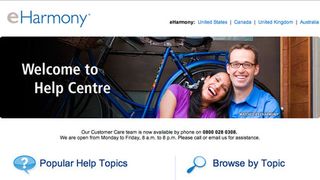Digital love: how data can help your dating
Online dating site eHarmony reveals all

With the rise of social networks and a trend to revealing more than we should about ourselves online, the stigma that used to be attached to online dating websites is fading fast.
In fact, it's now just as common for singletons to log on to find a partner as it is for them to go to the pub and sheepishly eye someone up in the corner.
When it comes to dating sites, though, it's not as much about love at first sight but love at first insight – and one website which reckons it has got this nailed is eHarmony.
Founded in 2000 in the US by a marriage councillor who decided to turn his decades of experience with warring couples into a website, eHarmony is well known for its rather laborious sign up process.
This equates to around 250 questions a member needs to answer before they even get a sniff of a date.
According to eHarmony…
1. Yoga is the most popular exercise among members
Get daily insight, inspiration and deals in your inbox
Get the hottest deals available in your inbox plus news, reviews, opinion, analysis and more from the TechRadar team.
2. Foodies have more of a chance of finding love
3. Men prefer woman who don't fritter money
4. Women prefer men who don't shop
5. Those with a dark humour prefer people with a lighter humour
(8,000 people surveyed)
It is these questions, though, which act as your very own Cupid, giving the site the data it needs to crunch so that it can match you up to a prospective partner.
"The questionnaire helps us build our psychological profile. This also qualifies upfront the people who are serious and the ones who are less serious," explained Joseph Essas, the head of computational science and technology at eHarmony to TechRadar.

"We then get our members into groups and tell them that this or that group of people fit their profile. This is where the computational science kicks in."
Long-term love
According to Essas, its members aren't there for a quick fling – "we don't allow any searching, the site isn't a meat market" – eHarmony is strictly for those looking for long-term compatibility and its algorithm can spot these signs that are normally invisible to those who date in the analogue world.
eHarmony: "Netflix and Amazon can show you a movie you might like but in eHarmony's case the movie has to like you back."
"We help you with the chemistry; we highlight things you have in common," explained Essas. "The only thing that you need to solve for yourself is the physical attraction part."
As well as the mountain of data the site mines from you in its questionnaire, eHarmony also analyses real-life couples who haven't found love through its own system and uses this data to bolster the information it already has.
"We have a lab where we bring couples to and we track them over time and see what parts of their personality work with each other and what parts don't," said Essas.
"My team then works with all the data to narrow down the compatibility. We have 40 million people in the database, so with the questions we can narrow this down for members to say 500."
From there, those looking for love can pick and choose the members they feel they will have fun with and take the dating into the real world.
Marc Chacksfield is the Editor In Chief, Shortlist.com at DC Thomson. He started out life as a movie writer for numerous (now defunct) magazines and soon found himself online - editing a gaggle of gadget sites, including TechRadar, Digital Camera World and Tom's Guide UK. At Shortlist you'll find him mostly writing about movies and tech, so no change there then.

